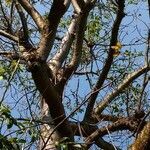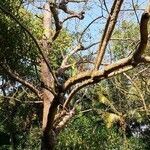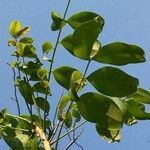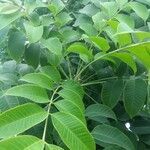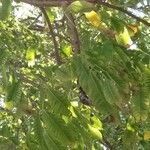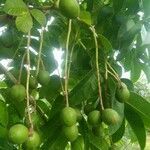Deciduous trees, 10-15 m tall; branchlets yellowish brown, glabrous. Petiole 10-15 cm, petiole and rachis glabrous; leaf blade 30-40 cm, imparipinnately compound with 5-11 opposite leaflets; leaflet petiolule 3-5 mm; leaflet blade ovate-oblong to elliptic-oblong, 7-12 × 4-5 cm, papery, glabrous on both sides, base cuneate to rounded, often oblique, margin serrate or entire, apex acuminate, lateral veins 12-25 pairs, slightly impressed adaxially, prominent abaxially, joined with submarginal collecting vein. Inflorescence paniculate, terminal, 25-35 cm, glabrous, basal first order branches 10-15 cm. Flower sessile or subsessile, white, glabrous. Calyx lobes triangular, ca. 0.5 mm. Petals ovate-oblong, ca. 2.5 × 1.5 mm, apically acute. Stamens ca. 1.5 mm. Ovary subglobose, ca. 1 mm; styles 4 or 5, free, ca. 0.5 mm. Drupe ellipsoid to elliptic-ovoid, yellowish orange at maturity, 3.5-5 × 2.5-3.5 cm; inner part of endocarp woody and grooved, outer part fibrous; mature fruit usually with 2 or 3 seeds. Fl. Apr-Jun, fr. Aug-Sep.
A medium sized tree. It grows 15-40 m high. The trunk can be 60-100 cm across. The leaves are 20-60 cm long and made up of several leaflets. The leaves and leaflets are carried alternately. The leaflets are pointed at the tip and rounded at the base. The leaflets are 7 to 14 cm long by 2.5-6 cm wide. There are 5-11 leaflets with a leaflet at the end. The flowers are in a long panicle at the ends of branches. The flowers are greenish-white. The fruit are rounded and yellow with an edible pulp around a fibrous stone. The fruit can be 4-7 cm long.
